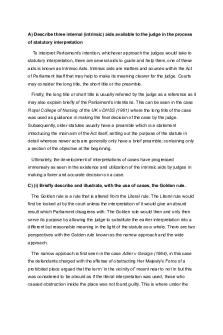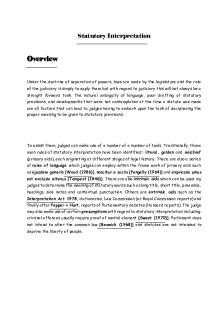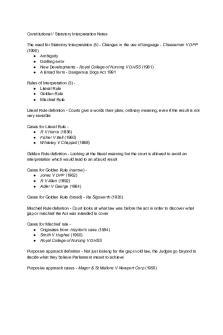Statutory interpretation notes PDF

| Title | Statutory interpretation notes |
|---|---|
| Course | Criminal Law |
| Institution | Brunel University London |
| Pages | 2 |
| File Size | 38 KB |
| File Type | |
| Total Downloads | 88 |
| Total Views | 143 |
Summary
Download Statutory interpretation notes PDF
Description
Statutory interpretation question 1 A. Describe the literal rule using the source and other cases to illustrate your answer. (15) The literal rule is using the plain dictionary meaning of the act as seen in line 14 of the source. The literal rule although the easiest to use can lead to very obscure results as in most cases the literal meaning of the words may not link directly to the case and therefore cause absurd, unjust and unrealistic results. An example of where the literal rule causes absurd results is Cheeseman v DPP, in this case the D was found exposing himself to two plain clothed police officers in a public toilet and was charged with indecently exposing himself to the annoyance of passengers. When the court used the literal rule they decided that the police were not passengers as they were stationed in the public toilet, therefore Cheesemans case was quashed even though he clearly committed the act that parliament intended to criminalize. Therefore using the literal meaning to the entire act Can lead to absurd results as it takes each word to exact, leaving no room for interpretation. An example of unjust results due to the literal rule is the London and north eastern railway co v Berriman case. In this case the Victim was oiling the railway line but was struck and killed by an oncoming train which he should have been warned of. Under the act the wording was ‘relaying or repairing’ where as the court decided that he was maintaining which meant that the case was not applicable to the act and therefore the widow of the man was refused any compensation. This was unjust as Berriman should have been warned of the oncoming train and the fact that he wasn’t should have meant compensation as the Act intended for these people to be helped In an accident- not only people relaying or repairing . Whitely v Chappell showed that the literal rule leads to unrealistic results, in this case the D used a dead man’s vote thus gaining an extra vote which parliament can’t have intended to happen. The court used an act that stated ‘any person entitled to vote’ when they used the literal rule they were unable to apply whitelys case to the act as he used a dead mans vote which meant that he wasn’t entitled to vote as he couldn’t. This was unrealistic as the man still gained an extra vote and therefore went against the law. The literal rule does however respect the theory of separation of powers as the court follows exactly what parliament said. Another benefit is that it leads to consistent results as they follow the exact act, whereas the other rules may be unpredictable.
B. I)(5) the most appropriate aid here would be the extrinsic aid of Hansard, this is the record of parliamentary debates on certain areas and topics. This would be helpful as it would show the meaning of the words in context and what parliament truly intended the meaning of the word to be. However Hansard can only be used as an aid if it follows all of the conditions set out by the case of Pepper v Hart. ii)(5) The most appropriate aid here is law reform reports which is an example of an extrinsic aid. This is where the courts or HOL uses the reports on certain law reforms, good here as the
law commission is part of the law reform and therefore finding the gap in the act made by them would be found in these reports. iii)(5)the best aid here is intrinsic- marginal notes as they are put in by draftsmen themselves and the notes made on the margin of the act would be helpful to find the intended meaning of the word. When first made however they were not seen as a good aid to use as they were not official.
C. I) describe the mischief rule(15) The mischief rule is the oldest rule of them all and stemmed from Heydons case (seen in line 1 of the source). Heydons case has 4 parts these are: - What was the law before the act was made? - What mischief did the act not provide for? - What did parliament propose? - What was the reason for what they proposed? The mischief rule is what parliament intended to “remedy”, it takes into account the problem with the common law. However the rule was changed slightly by the Jonesv Wrotham Park settled estates- shown in the source between line4-13. The source shows the new 3 conditions that are to be used in the mischief rule. One case that uses the mischief rule is Corkey v Carpenter in this case the D was drunk when riding a bike, the act states that anyone drunk and on a ‘carrage on the highway could be arrested’ the court agreed that for the purposes of the act a bike could be considered a carriage as the act was in place to prevent drunk people being on a highway to keep order and safety. Another case that used the mischief rule was Smith v Hughes, where a set of prostitutes were caught trying to attract men from a balcony and windows, in the act it stated that they couldn’t do this in a public place or street. They argued that they weren’t in a public space but the court found that the mischief act was still committed as they were projecting the act onto a public space....
Similar Free PDFs

Statutory interpretation notes
- 2 Pages

Statutory Interpretation
- 6 Pages

Statutory Interpretation
- 6 Pages

Statutory Interpretation Notes
- 9 Pages

Statutory Interpretation Notes
- 4 Pages

Statutory Interpretation
- 3 Pages

Statutory Interpretation
- 5 Pages

Statutory Interpretation
- 11 Pages

Statutory Interpretation
- 6 Pages

Statutory Interpretation 70102
- 5 Pages

Statutory Interpretation in Malaysia
- 12 Pages
Popular Institutions
- Tinajero National High School - Annex
- Politeknik Caltex Riau
- Yokohama City University
- SGT University
- University of Al-Qadisiyah
- Divine Word College of Vigan
- Techniek College Rotterdam
- Universidade de Santiago
- Universiti Teknologi MARA Cawangan Johor Kampus Pasir Gudang
- Poltekkes Kemenkes Yogyakarta
- Baguio City National High School
- Colegio san marcos
- preparatoria uno
- Centro de Bachillerato Tecnológico Industrial y de Servicios No. 107
- Dalian Maritime University
- Quang Trung Secondary School
- Colegio Tecnológico en Informática
- Corporación Regional de Educación Superior
- Grupo CEDVA
- Dar Al Uloom University
- Centro de Estudios Preuniversitarios de la Universidad Nacional de Ingeniería
- 上智大学
- Aakash International School, Nuna Majara
- San Felipe Neri Catholic School
- Kang Chiao International School - New Taipei City
- Misamis Occidental National High School
- Institución Educativa Escuela Normal Juan Ladrilleros
- Kolehiyo ng Pantukan
- Batanes State College
- Instituto Continental
- Sekolah Menengah Kejuruan Kesehatan Kaltara (Tarakan)
- Colegio de La Inmaculada Concepcion - Cebu




